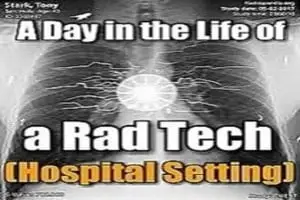When it comes to the daily hustle and bustle of a radiologic technologist, there are no two days (or shifts) that are exactly the same. But if you are wondering what a typical day looks like, it is something similar to this:
Clock in and get your shift report. Make sure your area is set up and ready to see patients. Check your worklist and triage which patients will take priority…for now. Then start taking images of one patient at a time.
This is pretty standard for hospital imaging departments. Outpatient clinics will vary a little. They won’t have much triaging to do. It’s mostly first to come, first served. Mobile imaging techs have a similar routine but have to manage the daily driving route. Let me share what I know from 15+ years as a tech.
Larger departments will assign rad techs to different areas of the hospital for better coverage and accountability. But if you aren’t busy in your assigned area, you are expected to help wherever needed. Typical assignments are:
- Emergency Room
- Operating Room
- Critical Care Units
- Main Department
The Xray Control Area
 The “control area” is the hub of the department for any modality. It is a place for techs to sit and relax between patients. There are computers and processors for logging paperwork and processing images. Communication memos are hung on the walls containing assignments like:
The “control area” is the hub of the department for any modality. It is a place for techs to sit and relax between patients. There are computers and processors for logging paperwork and processing images. Communication memos are hung on the walls containing assignments like:
- what unit each tech is assigned to for the day,
- what time each tech gets lunch and
- who signed up to go home early.
This is where you are expected to be if you aren’t taking care of a patient. As a technologist, you spend a lot of your time in this area. Mostly starting and finishing your exams (electronic or paper). You rest when you can but don’t expect much. With any luck, when you finally do get a collective break as a group… that’s when an administrator will walkthrough.
This area also serves as the modality library. Reference books dating back to the 1970s will spread across the top shelves. The books without spider webs will be the recently donated textbooks. The books are happily handed down from recent graduates who are just glad to be out of school. Little do they know those books will be needed as a reference for a few more years.
Breakroom or Tech Lounge
Sizes vary greatly in these areas. Anywhere from several tables to two small chairs. You spend your two 15-minute breaks and 30-minute lunch here unless you make plans to meet someone in the cafeteria. You don’t have enough time to go off-campus. There’s always a tv but not always a remote and no guarantee to get more than a few channels. You can kill a few minutes checking out the community corkboard to see if anything interesting is posted. Usually just a potluck announcement and something about handwashing techniques.
For a good lesson in space management, you should check out the staff refrigerator. Every square inch will be smashed full of mystery containers, drinks, and flavored coffee creamers. The freezer should have a least one popsicle and two expired frozen dinners. You might be tempted to think you could swipe an energy drink from that chaos but make no mistake, every tech in the place knows exactly what they have in there (whether they will admit it or not.)
Examination Rooms
This is where the fun happens. Inserting contrast into places designed for exit-only traffic. Asking patients who don’t speak any English to hold their breath. Trying your best to get the perfect cross-table hip on an elderly patient with dementia. Or quickly locking a two-month-old in the torture chamber surely derived during the dark ages called a pig-o-stat.
This is the place where skill, education, and determination are tested daily. How can you get the best image with the least amount of radiation while keeping the patient as comfortable as possible? You will spend some time each shift restocking these rooms with supplies like cleaning wipes, gowns, towels, gloves, masks, sheets and blankets. A good tech will also wipe down anything the patient touches after every exam. You will spend the majority of your shift running back and forth between the exam room and the control room.
The Emergency Department
If your facility approves of using portable machines at the bedside, you will spend a quarter of your time in the ED. Otherwise, you will be examining the emergency patient in your exam room (minus the real traumas.) Here you will see anything and everything. You will see things you will never forget… especially if you work in a level one trauma center.
But don’t think that you won’t see gruesome stuff working in a small rural hospital. It will find you no matter where you work in this field. You will have to take an x-ray of the hand missing fingers. The leg with a foot hanging off to the side. You won’t believe some of the things you will see here. This job is not for the faint of heart. If this bothers you or you have a weak stomach, you should consider working in a clinic.
The emergency room staff will not be forgiving either, They have seen it all and will expect you to get in and do your job. The nurses, doctors and other team members in the ED will admit to being adrenaline junkies. Seeing extreme situations and being able to remain calm and perform their duties is their way of life. You will have to learn to do the same.
ICU, CCU, NICU are Critical Units
 Critical care units house the sickest of patients. The intensive care unit is where you will see some of the most critical people. Patients on ventilators, mechanical breathing machines, who are unable to breathe on their own are cared for here. Critical care units are the same way. Sometimes they naturally can’t breathe on their own and sometimes are chemically induced into a coma for recovery. You will spend about 10-15 percent of your shift here because these patients commonly need daily chest x-rays. It will be your job to go there quickly when needed for chest x-rays or line placements.
Critical care units house the sickest of patients. The intensive care unit is where you will see some of the most critical people. Patients on ventilators, mechanical breathing machines, who are unable to breathe on their own are cared for here. Critical care units are the same way. Sometimes they naturally can’t breathe on their own and sometimes are chemically induced into a coma for recovery. You will spend about 10-15 percent of your shift here because these patients commonly need daily chest x-rays. It will be your job to go there quickly when needed for chest x-rays or line placements.
And as tough as it is seeing these patients in critical care, the most difficult sometimes is the neonatal intensive care unit. This is where the sickly little babies are cared for and treated. They need x-rays just like everybody else. But the utmost care is needed when doing an x-ray in this location. One wrong move and you can accidentally pull out an intravenous line or feeding tube. These are very difficult to place on tiny babies and nobody is happy if they have to reinsert one because of a lazy rad tech.
Routine Inpatients and Outpatients
The rest of your shift will be spent performing exams on routine inpatients and “walkie talkie” outpatients. Some of these inpatients can get an x-ray in their rooms with a portable machine but most will visit the main imaging department.
Your typical day as a radiologic technologist is to do your best for each and every patient you see. Treat them as if you were taking care of your own family member and get the best image study for the purpose it was ordered. At the end of your shift, you should report out to the next team of imaging techs coming on for the night. Let them know if any patients are still waiting for exams. Is there any equipment that isn’t functioning properly and whether or not you contacted the repair team. Lastly, make sure you restocked all of the supplies you used on your shift.
Then go home, rest… and feel proud that you helped so many people.
Additional Information:
If you are curious about the career of radiography, I have written some articles on various topics:
- How much does x-ray pay,
- 7 dangers of being a rad tech,
- Different ways to pay for radiography school,
- How to get accepted into a rad tech program,
- Can you work full-time while going to rad tech school and
- 5 reasons I chose a career in radiology.
Radiology Tech Salary per Hour – I Know, I AM One!

